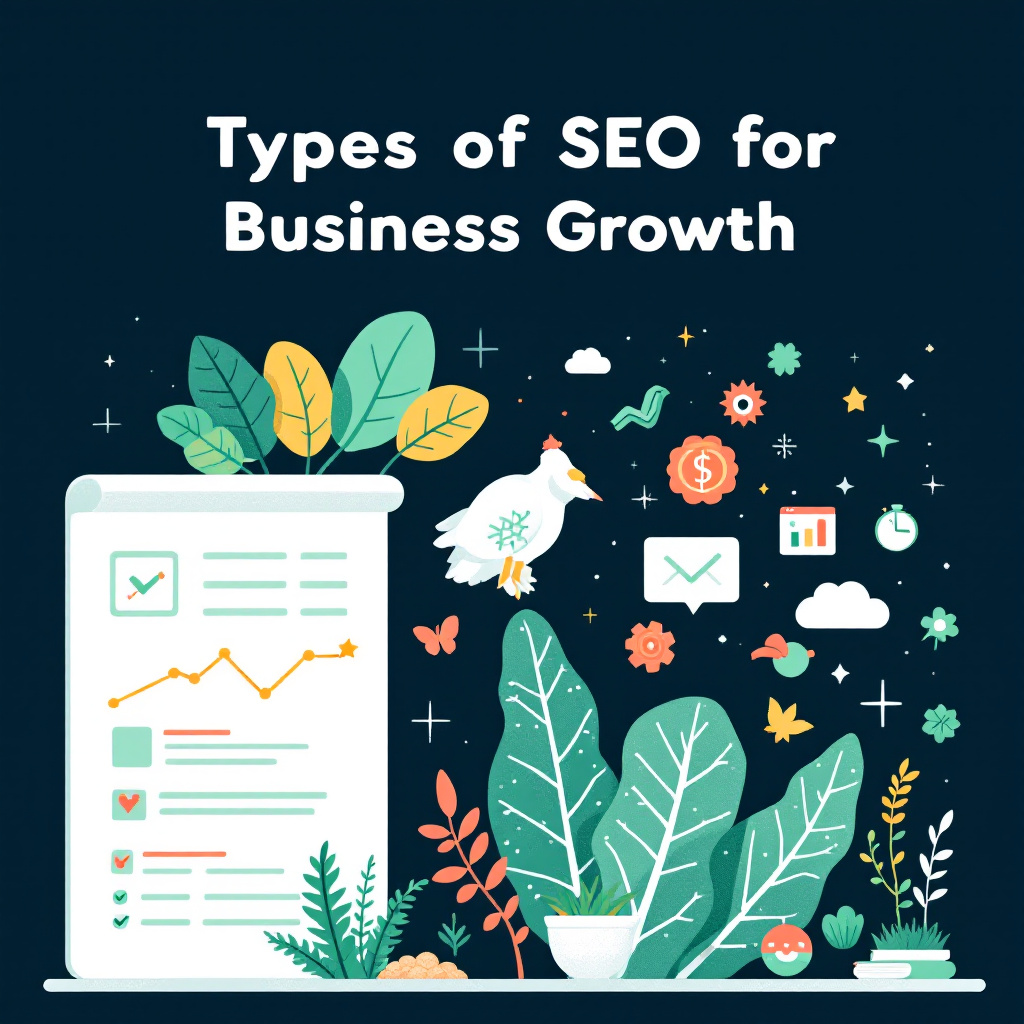If your business relies on an online presence, understanding different types of SEO isn’t optional—it’s essential. Search engines drive most website traffic; without proper optimization, your site risks being invisible to potential customers. By mastering the core types of SEO—like on-page, off-page, and technical—you can dramatically improve your website’s performance. Combined with specialized strategies like local or e-commerce SEO, these approaches help attract the right audience, boost visibility, and guide consistent growth. Ready to unlock your website’s full potential? Let’s get started.
On-Page SEO: Building the Foundation for Website Success
Optimizing your website’s different types of SEO is a complex task. On-page elements are one of the most direct ways to improve search engine rankings and user experience. On-page SEO focuses on everything you can tweak directly on your site, from keywords to media. It is essential for creating a cohesive, user-friendly platform that search engines trust. Let’s break it down.
Keyword Optimization
The right keywords make all the difference in helping users and search engines understand what your page offers. Start with research to identify high-performing keywords, focusing on search intent and relevancy to your audience. Once you’ve nailed this, seamlessly integrate these keywords into your:
- Headings (H1, H2, and beyond)
- Meta titles and descriptions
- Body Content
Avoid overloading your page with keywords (“stuffing”), as search engines penalize this tactic. Instead, strike a balance by using related terms and phrases naturally. Think of your website like a conversation; keywords are just the points you emphasize.
Content Creation and Quality
Search engines love quality content because users do, too. Crafting original, informative, and engaging content is non-negotiable in on-page SEO. Whether it’s a blog post, product page, or landing page, your content should:
- Address the needs and questions of your audience.
- Be well-structured with logical headings and short paragraphs.
- Offer unique insights or value your competitors don’t provide.
Remember: Google increasingly prioritizes content demonstrating E-A-T—Expertise, Authoritativeness, and Trustworthiness. Your content should be well-researched, accurate, and easy to read.
Meta Descriptions and Title Tags
First impressions count, especially on search engine results pages (SERPs). Compelling title tags and meta descriptions help you rank higher and drive more clicks. Here’s how to optimize them:
- Title Tags: Keep them under 60 characters, include your main keyword early, and make them descriptive yet enticing.
- Meta Descriptions: Summarize the page content in under 160 characters and motivate users to click with specific benefits or features.
For example, compare “Shop shoes online” to “Shop stylish, affordable shoes with free shipping on all orders.” One screams generic, while the other adds value.
Image and Multimedia Optimization
Your images and videos are more than visual touches; they’re SEO assets. To optimize them:
- Use descriptive, keyword-rich alt text for accessibility and search visibility.
- Compress images to reduce load times without sacrificing quality.
- Choose the right file formats, such as JPEG for standard images and WebP for faster loading.
Don’t forget captions and structured media placements to improve the user experience. When your visuals load fast and help users navigate your page easily, everybody—search engines included—wins.
Internal Linking
Internal links weave your website together, guiding users and search engines through your content. They offer multiple benefits, including:
- Improved Navigation: Users can easily explore related topics or services.
- SEO Boost: Links help search engines understand your content hierarchy and distribute link equity.
- Lower Bounce Rates: Visitors are likelier to stay on your website longer.
For instance, if you’ve written a blog post about “choosing keywords,” link it to other related blogs like “Types of SEO” or “How to track keyword success.” The key is relevance—don’t force links where they feel out of place.
By intentionally addressing these on-page SEO factors, you’re improving your website’s search rankings and creating a better experience for your audience. This attention to detail builds trust, leading to more traffic, longer site visits, and higher conversions.
Off-Page SEO: Building Authority Beyond Your Website
Off-page SEO is about boosting your website’s authority and visibility through efforts outside your site. These external strategies are key to building trust with search engines and signaling that your site is a credible resource. Let’s explore the types of SEO that are the most impactful when using off-page SEO to help your business grow.
Backlink Building
Backlinks are like votes of confidence from other websites—they tell search engines that your site is trustworthy and valuable. However, it’s not just about quantity; quality backlinks from reputable sites have a much bigger impact.
- Why do backlinks matter? Search engines like Google use backlinks as a ranking factor. Think of it as being recommended by someone well-respected in your industry. The more relevant and authoritative the referring site, the more weight your link carries.
- Focus on acquiring natural, relevant backlinks through methods like:
- Publishing high-quality, shareable content.
- Collaborating with influencers or industry leaders.
- Using tools for broken link building to replace outdated links with your content.
Remember, links from spammy or irrelevant websites can do more harm than good. Regularly auditing your backlink profile ensures you only benefit from high-quality connections, keeping your domain authority strong.
Social Media Engagement
Although social media isn’t a direct ranking factor for Google, it plays a crucial role in off-page SEO. Think of your social media platforms as amplifiers for your website.
- Boosting Brand Awareness: Frequent sharing of engaging content increases exposure and drives traffic to your site. The more people interact with your posts, the more likely they will link to your site.
- Encouraging Social Mentions: Positive mentions or shares on platforms like LinkedIn, Twitter, or Instagram create indirect SEO benefits, such as:
- Generating referral traffic.
- Building online buzz that could turn into high-quality backlinks.
Social media allows you to engage directly with your audience, building trust and fostering relationships that translate to stronger brand authority.
Guest Blogging and Outreach
Guest blogging is more than an opportunity to share your expertise; it’s one of the best ways to build your site’s credibility and improve SEO. The concept is simple: write valuable content for websites in your niche in exchange for a link to your site.
- Why guest blogging works: It taps into existing audiences on trusted platforms, increasing your exposure while gaining authoritative backlinks.
- How to get started:
- Research industry blogs or websites that have a significant following and align with your target audience.
- Pitch well-thought-out, relevant topics that add value to their readers.
- Build relationships with site owners or editors to increase long-term collaboration opportunities.
In addition to guest posting, proactive email outreach can open doors to digital PR opportunities like interviews, podcast appearances, or content mentions. These efforts improve your SEO and solidify your standing as a thought leader in your industry.
From the different types of SEO, Off-page SEO extends your reach far beyond your website. From earning links on authoritative websites to driving traffic through social media and guest blogging, these strategies create a ripple effect that signals credibility and relevance to search engines.
Technical SEO: Building a Strong Foundation for Search Engines
Technical SEO ensures your website is primed for search engines to crawl and index your content efficiently. Without it, even the other types of SEO, like the best on-page or off-page strategies, can fall flat. From site speed to mobile optimization, technical SEO addresses crucial backend factors directly impacting your site’s visibility and user experience. Let’s unpack the essentials.
Website Speed and Performance
A slow website is the quickest route to high bounce rates and frustrated users. Studies show that users expect pages to load in under 3 seconds, and search engines prioritize fast-loading sites in rankings.
Google’s Core Web Vitals take this further by focusing on critical speed and user interaction metrics like Largest Contentful Paint (LCP) and First Input Delay (FID). Improving your site speed can involve:
- Using a content delivery network (CDN) to reduce latency for global users.
- Compressing images and media files to cut down on load times.
- Enabling browser caching to store reusable elements locally for returning visitors.
Remember, milliseconds matter. A faster website keeps visitors around longer and gives you a significant SEO edge.
Mobile-Friendliness
With mobile devices accounting for over half of all web traffic, optimizing for mobile isn’t optional—it’s essential. Google’s mobile-first indexing means search rankings are primarily based on your site’s mobile version. If your site isn’t responsive, you’re already losing ground.
How can you make your site mobile-friendly? Here are key strategies:
- Implement responsive design so your site automatically adjusts to different screen sizes.
- Avoid intrusive pop-ups that block content on small screens.
- Optimize touch elements—like buttons and links—which should be big enough and spaced properly for easy tapping.
If your site doesn’t work seamlessly on a smartphone, users won’t stick around, and neither will your search engine rankings.
URL Structure and Site Hierarchy
Clean, logical URLs and a well-organized site hierarchy aren’t just good for users—they’re essential for search engines. A clear structure helps search engines crawl and index your pages efficiently, improving your chances of ranking.
Here’s what a clean URL and site structure look like:
- Short and descriptive URLs: Instead of “example.com/p=1234,” go with “example.com/technical-seo-tips.”
- Logical categories: Group related pages under parent categories to make navigation intuitive. For example:
- example.com/seo/technical-seo/
- example.com/seo/on-page-SEO/
- Internal linking: Build a web of links that connect related content and guide visitors (and search bots) through your site.
A messy site structure confuses users and search engines, hurting your rankings. Keep it simple and intuitive.
Security Protocols (HTTPS)
HTTPS isn’t just a “nice-to-have” anymore—it’s a requirement. Not only does it secure data between your site and its users, but search engines also favor HTTPS websites in rankings. Chrome, for instance, labels non-HTTPS sites as “Not Secure,” which can quickly erode trust.
Switching to HTTPS involves:
- Installing an SSL certificate.
- Redirecting HTTP pages to their HTTPS counterparts to avoid duplicate content issues.
- Regularly renewing your SSL certificate to maintain encryption.
A secure website builds trust and offers visitors and search engines peace of mind. Additionally, with data privacy on everyone’s radar, HTTPS is non-negotiable for protecting sensitive user information.
By mastering these core components of the different types of SEO, like technical SEO, you pave the way for better crawlability, faster performance, and stronger rankings. Ready to dive deeper? More strategies await in the next section.
Local SEO: Capturing Customers Near You
Local SEO helps businesses connect with nearby customers who are actively searching for their products or services. Unique from the other types of SEO, optimizing for local search ensures you’re visible when it matters most if you’re targeting a specific geographic area. Here’s how you can make the most of local SEO:
Google Business Profile Optimization
Your Google Business Profile (GBP) is often the first thing potential customers see when searching locally. A well-optimized profile can dramatically improve your visibility in Google’s Local Pack and Maps results.
Here’s how to get it right:
- Fill out every detail: Ensure your business name, category, phone number, website link, and hours of operation are accurate.
- Use high-quality photos: Include images of your storefront, products, or services to make your profile visually appealing.
- Pick the right categories: Be specific when selecting business categories. Avoid being generic.
- Add keywords where relevant: Include location-specific and service-related terms in your business description.
- Stay active: Post regular updates, like promotions or events, to signal engagement to customers and search engines.
- Answer questions: Use the Q&A section to clarify common inquiries while demonstrating responsiveness.
A polished Google Business Profile establishes trust and positions your business as a local authority.
NAP Consistency
Consistency in your Name, Address, and Phone number (NAP) across the web is crucial for local SEO. Search engines compare NAP information from different sources to verify your business’s legitimacy. Inconsistent details can confuse both search engines and potential customers.
Best practices for maintaining consistent NAP info:
- Double-check the details on your website to ensure they match your GBP exactly.
- Update any platforms where your business is listed, like Yelp, Facebook, or local directories.
- Use identical formatting (e.g., “Street” vs. “St.”) for all listings.
- Audit your NAP citations regularly using tools like Moz Local or BrightLocal.
Making your business easy to find and contact starts with consistent, accurate NAP information.
Local Keywords and Content
Winning the local SEO game begins with targeting the right location-specific keywords. You want to capture users searching for information about your area and industry.
Here’s how to target local keywords effectively:
- Use keyword research tools: Tools like Google Keyword Planner or Ahrefs can help identify location-focused search terms.
- Incorporate “near me” searches: Include phrases like “pizza delivery near me” since these often trigger local results.
- Create localized content: Write blog posts or pages focusing on local events, news, or community interests related to your niche—for example, “Best Summer Events in Austin for Fitness Enthusiasts.”
- Optimize titles and meta descriptions: Include the city or neighborhood name when appropriate to improve search results.
Local content doesn’t just drive organic traffic; it also reinforces your authority within your community.
Customer Reviews and Reputation Management
Online reviews are the digital equivalent of word-of-mouth recommendations and play a huge role in local search rankings. Google trusts businesses with plenty of positive, authentic reviews.
Here’s how to manage reviews like a pro:
- Encourage satisfied customers: Politely ask happy clients to leave reviews on Google or other platforms.
- Respond promptly: Responding to reviews (both positive and negative) shows you care about customer feedback.
- Address negative reviews calmly: Apologize where necessary and try to resolve the issue. This can turn an unhappy customer into a loyal one.
- Highlight reviews on your site: Add testimonials to your website to amplify trust.
- Avoid fake reviews: Buying reviews or manipulating feedback can lead to penalties. Stick with genuine reviewer experiences.
A strong review profile boosts your local rankings and convinces customers to choose your business over competitors.
By focusing on these strategies, your business can dominate local search results, helping neighbors and visitors find exactly what they need—right when they need it.
How Types of SEO helps in Unlocking Sales Potential for Online Stores
For online stores, SEO isn’t optional; it’s essential. Imagine having a beautifully designed store packed with great products—no one knows it exists. SEO is the tool that makes your store visible to potential customers searching for the exact items you’re selling.
Here’s how different Types of SEO impact your e-commerce business:
- Increased Visibility: When people search for products you sell, you want your store to appear on the first page of search results. Most users never scroll past the first page, so ranking higher improves visibility.
- Driving Traffic: Visibility leads to clicks, and clicks bring in visitors. The more people coming to your site, the more chances you have to make a sale. SEO gets you this consistent traffic without paying for ads every time.
- Higher Conversion Rates: SEO is not just about bringing people in; it’s about finding the right people. When optimized effectively, you attract shoppers already interested in your offer. This targeted traffic has a higher chance of converting into sales.
- Building Trust: Users trust search engines. Ranking higher tells potential customers that your store is reliable and trustworthy, which can influence their decision to purchase.
Think of the different types of SEO as the digital equivalent of setting up your store on a busy street versus a back alley. The more visible and accessible your site is, the better your chances of growing your customer base and increasing sales. With the right SEO strategy, your online store can become a top destination for shoppers in no time.
Content Marketing and Blogging
Creating consistent, valuable content isn’t just a nice-to-have—it’s essential for building trust, driving organic traffic, and positioning your online store as a go-to resource. Content marketing turns casual readers into loyal followers ready to buy when done right.
Here’s how blogging and content marketing can maximize your store’s sales potential:
- Answer Common Customer Questions: Consider what your target audience is searching for. Are they looking for tips, reviews, or solutions to specific problems? Offer helpful blog posts, how-to guides, and product comparisons. For instance, an online shoe store could write, “How to Choose the Perfect Running Shoes for Your Needs.”
- Use Keywords Naturally: Each post should target keywords with high traffic potential. Include them in your headlines, subheadings, and body text naturally. But don’t overstuff; always prioritize readability.
- Internal Links: Link to your products or related blog posts within your content to guide readers further into your site and increase the chances of a sale.
- Evergreen Content: Focus on relevant topics over time rather than chasing fleeting trends. “How to Care for Leather Boots” will stay useful for years, unlike seasonal sales-related posts.
By writing with your customer in mind and sprinkling in a little SEO magic, you not only generate traffic but also create stronger connections that bring people back to shop again
Conclusion
To achieve sustainable online growth, integrating different types of SEO is essential. Each plays a unique role—on-page enhances user experience, off-page builds authority, technical ensures structure, local captures nearby audiences, and e-commerce focuses on conversions.
Align your SEO efforts with your business goals to maximize visibility and performance. SEO isn’t a one-size-fits-all solution; a strategic blend tailored to your needs drives results.
Start implementing these methods today to outshine competitors and secure your spot at the top of search results. Your next success is just a ranking away.





